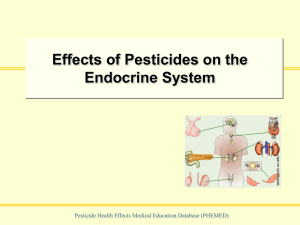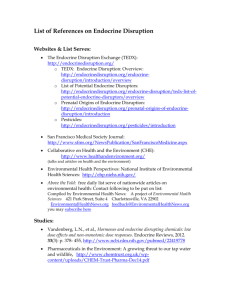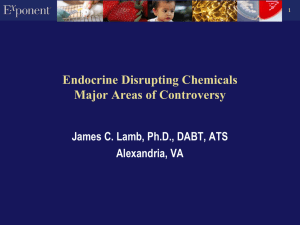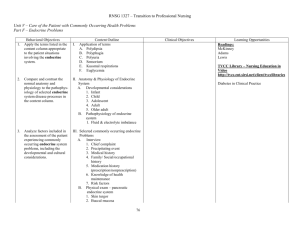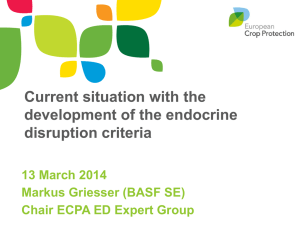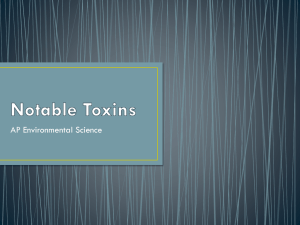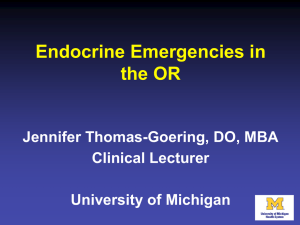Link:Presentation of Richard Sharpe
advertisement
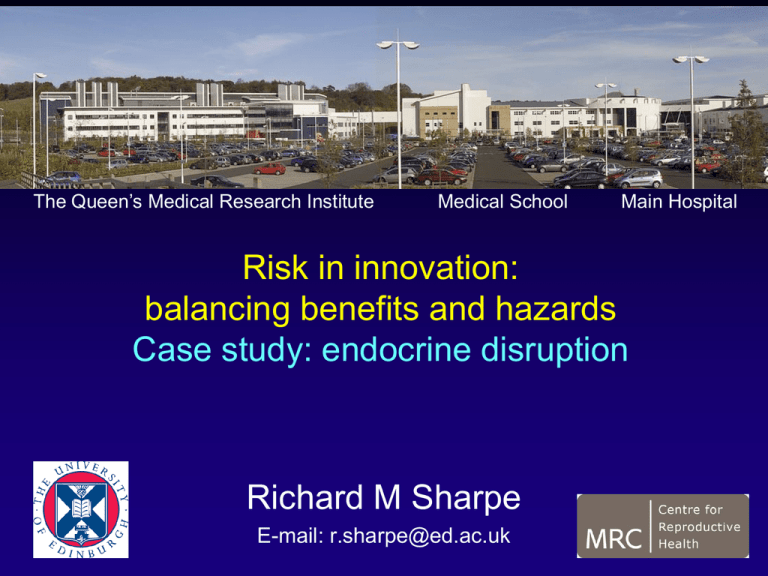
The Queen’s Medical Research Institute Medical School Main Hospital Risk in innovation: balancing benefits and hazards Case study: endocrine disruption Richard M Sharpe E-mail: r.sharpe@ed.ac.uk Endocrine disruption and human health An up-front reality check Endocrine disruption is responsible for a major portion of human health disorders and is certainly responsible for the changing face of human disease – so-called ‘Western diseases’ Therefore, identifying the causes and preventing them is both desirable and feasible The big issue is what is causing the endocrine disruption? Is it environmental ‘endocrine disruptors’ or is it other factors related to our modern lifestyle? Endocrine disruption is all around us Eating and drinking causes ‘endocrine disruption’ Diet, hormones and getting fat Hormone effects of eating ‘high sugar’ foods So, is sugar an endocrine disruptor? Eating and drinking causes ‘endocrine disruption’ Increase in visceral (intra-abdominal) fat leads to a decrease in circulating testosterone levels (even in young men) Relationship between blood testosterone and metabolic syndrome features in adult men From: Traish et al (2011) Amer J Med 124: 578-587 Endocrine disruptors Definition – why the concern Endocrine disruptors are exogenous substances that alter function(s) of the endocrine system and consequently cause adverse health effects in an intact organism, or its progeny, or (sub)populations A Many man-made chemicals have intrinsic agonistic or antagonistic hormonal activity and may thus affect one or more hormone systems in the body. Examples are: alklyphenols, DDT, certain other pesticides, bisphenol A B Other compounds have activities that alter endogenous hormone production within the body. Examples are certain phthalates, azole compounds, bisphenol A The commonest reproductive disorders of the developing and young adult male ‘Testicular dysgenesis syndrome (TDS)’ Testis GC cancer Low sperm counts Low testosterone Cryptorchidism Hypospadias ? Subnormal T production or action An animal model for human TDS? •Gestational exposure (E13-E21) of the rat to high doses of certain phthalate esters [eg dibutyl phthalate (DBP) or diethylhexyl phthalate] results in: Dose-dependent induction of: •Cryptorchidism •Hypospadias •Low testis weight/subfertility •Abnormalities in fetal germ cell development •Suppression of fetal testosterone and Insl3 •Reduction in anogenital distance (AGD) Exposure of pregnant rats to a plasticiser (dibutyl phthalate (DBP; 500mg/kg/day) reduces fetal testosterone Control DBP Partly from Scott et al (2008) Endocrinology 149:5820 Fetal human testis xenografting into (castrate male) nude mice • Grafts grow normally for 6+ weeks • Treating the host with DBP is thus like experimentally exposing the real human fetal testis • Can measure testosterone production by the grafts Exposure of human fetal testis xenografts to 500mg/kg/day DBP has no steroidogenic effects Xenografts recovered + 6 weeks; hCG treatment from 1-6 weeks Data show Means ± SEM for N=8 fetuses (14-20 weeks’ gestation) Statistical analysis was by paired t test From Mitchell et al (2012) JCEM 97: E341-E348 The (ongoing) bisphenol A story ‘Feeding your baby from a polycarbonate milk bottle* is like feeding it a contraceptive pill’ (Fred vom Saal) *containing bisphenol A, which has weak estrogenic activity Bisphenol A estrogenicity The reality The reality is that you would need thousands of ‘bisphenol A pills’ to match an oral contraceptive pill for estrogenic potency So what is the ‘truth’ about bisphenol A? Is it an ‘obesogen’? •We are all exposed •Our main route (95%) of exposure is dietary (oral) •Conjugation of BPA occurs rapidly in the body rendering it biologically inactive •Most measurements of BPA in the body (including exposure) are detecting primarily conjugated BPA Effect of switching to a fresh food diet for 3 days on Bisphenol A exposure So a ‘healthier’ fresh food diet is associated with markedly lower BPA levels. Such a diet is also clearly associated with lower risk of obesity, type 2 diabetes, cardiovascular disease etc From: Rudel et al (2011) Environ Health Perspect 119: 914 This is what we suggest as a hypothesis – which requires urgent investigation RM Sharpe & AJ Drake Obesity, type 2 diabetes etc Western diet Higher bisphenol A exposure A real endocrine disruptor issue that will not go away The risk posed by exposure to ‘low level’ combinations of endocrine disruptors The ‘mixtures’ issue - ‘The cocktail effect’ Effects of perinatal exposure to mixtures of ‘anti-androgenic’ chemicals in rats Data courtesy of Earl Gray (EPA, USA) ‘Real-world’ exposure to environmental chemicals: effects on testis development Ewes reared on pasture fertilized with: •Conventional fertiliser (= control) •Sewage sludge* (= treated) For ~20 common contaminants quantified in mothers/fetuses there was no significant increase in sludge-exposed animals *According to EU recommendations Sperm production in adulthood in sheep after rearing on control or ‘treated’ pasture Adapted from Bellingham et al (2011) Int J Androl doi: 10.1111/j.1365-2605.2011.01234.x Another case of endocrine disruption? Thank you for your attention



